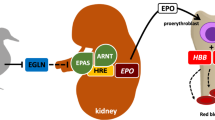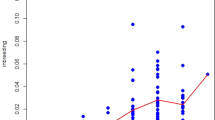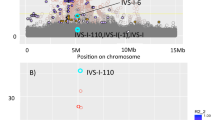Summary
In the first series, the average heterozygosity based on ten polymorphic loci (Rhesus, MN, P, and Kell blood groups; haemoglobin; serum haptoglobin; transferrin; red cell acid phosphatase, phosphoglucomutase-1 and glyoxalase-1) was determined among the offspring of unrelated (n=328) and related (first-cousin) matings (n=466) in the Sudan. The estimated average heterozygosity was found to be the same in the offspring of the first-cousin and unrelated parents (0.3628±0.0584 and 0.3697±0.0581, respectively). In the second series, the average heterozygosity at five polymorphic loci (Rhesus blood group, haemoglobin, serum haptoglobin and transferrin and red cell acid phosphatase) was estimated in several tribes with variable levels of inbreeding coefficients. The estimated average heterozygosity varied from 0.14±0.09 to 0.37±0.08 in different tribes with varying degrees of inbreeding coefficients (α×105 of 967−3,904). However there was no significant correlation between the level of parental inbreeding with either average heterozygosity or deviation from the Hardy-Weinberg equilibrium in the offspring.
Similar content being viewed by others
Log in or create a free account to read this content
Gain free access to this article, as well as selected content from this journal and more on nature.com
or
References
Bayoumi, R.A. and Saha, N. 1987. Some genetic characteristics of the Nuba and Hawazma tribes of the Sudan.Am. J. Phys. Anthropol. 73: 379–388.
Bayoumi, R.A., Taha, T.S.M. and Saha, N. 1985. A genetic study among the Fur and Baggara tribes in Gabal Merrah, the Sudan.Am. J. Phys. Anthropol. 67: 363–370.
Hann, K.L. 1985. Inbreeding and fertility in a South Indian population.Ann. Hum. Biol. 12: 267–274.
Rao, P.S.S.S. and Inbaraj, S.G. 1977. Inbreeding effects on human reproduction in Tamil Nadu of South India.Ann. Hum. Genet. 41: 87–98.
Rao, P.S.S.S. and Inbaraj, S.G. 1979a. Trends in human reproductive wastage in relation to long-term practice of inbreeding.Ann. Hum. Genet. 42: 401–413.
Rao, P.S.S.S. and Inbaraj, S.G. 1979b. Inbreeding effects on fertility and sterility in Southern India.J. Med. Genet. 16: 24–31.
Saha, N. and El Sheikh, F.S. 1987. Some blood genetic characteristics of several Sudanese tribes.Am. J. Phys. Anthropol. 73: 397–406.
Saha, N. and El Sheikh, F.S. 1988. Inbreeding levels in Khartoum.J. Biosoc. Sci. 20: 333–336.
Saha, N., Gumaa, K.A., Samuel, A.P.W. and El-Naeim, H. 1979. Placental alkaline phosphatase in a Sudanese population: polymorphism and enzyme activity.Hum. Biol. 51: 335–339.
Saha, N., Hamad, R.E. and Mohamed, S. 1989. Inbreeding effects on reproductive outcome in a Sudanese population.Hum. Hered. in press.
Saha, N., Samuel, A.P.W., Omer, A., Ahmed, M.A., Hussein, A.A. and El Nour Gaddoura, N. 1978. A study of some genetic characteristics of the population of the Sudan.Ann. Hum. Biol. 5: 569–575.
Sanghvi, L.D. 1982. Inbreeding in India.Soc. Biol. 29: 106–117.
Author information
Authors and Affiliations
Rights and permissions
About this article
Cite this article
Saha, N., Tay, J.S.H. & El Sheikh, F.S. Inbreeding effects on average heterozygosity in the Sudan. Jap J Human Genet 34, 225–229 (1989). https://doi.org/10.1007/BF01900725
Received:
Revised:
Accepted:
Published:
Issue date:
DOI: https://doi.org/10.1007/BF01900725
Key Words
This article is cited by
-
BRCA1 and BRCA2 status in a Central Sudanese series of breast cancer patients: interactions with genetic, ethnic and reproductive factors
Breast Cancer Research and Treatment (2007)



